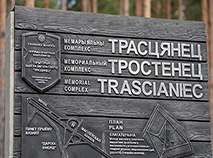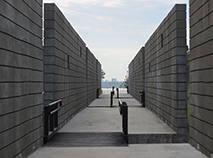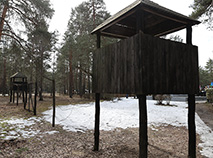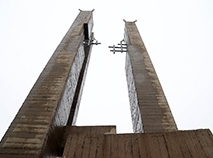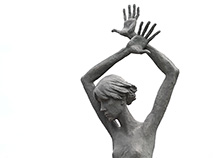Memorials at former death camps and ghettos
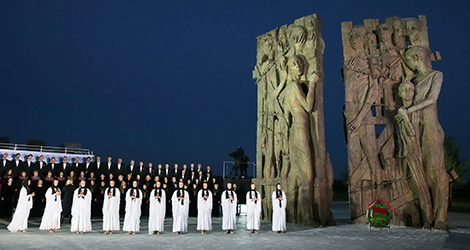
The Generalplan Ost that sought to enslave and exterminate people living in the USSR, the Jewish and Slavic populations of the occupied territories, spells out the true intentions of the Nazis. According to archival documents, a comprehensive program was developed to murder Jews and Slavs in line with the racist principles of Hitlerism.
Being in the epicenter of the war, Belarus lost over 2.2 million people. The occupiers burned and destroyed 209 out of 270 cities and towns, more than 11,000 villages... People were killed in Belarus every day, every minute. They were burned alive in barns, sent to gas chambers, shot and dumped into ditches...
Years later, the sites of the greatest tragedies were memorialized so that this merciless truth about the war on Belarusian soil and the genocide of its people would never be forgotten.
Khatyn, Dalva, Borki, Ola, Shunevka, Shaulichi are just a few of the hundreds of burnt villages that were reduced to ashes by punitive forces, and later became symbols of memory of innocent victims.
Trostenets, Ozarichi, Krasny Bereg, Lupolovo were the most notorious death camps in Belarus where the Nazis brutally exterminated hundreds of thousands of people... In total, there were more than 560 camps on the territory of Belarus. About 546,000 people were killed in Trostenets alone, which makes it Europe’s fourth largest death camp.
More than 380 ghettos were established by the occupiers across Belarus to implement the monstrous policy of “the Final Solution to the Jewish Question”. The Minsk Ghetto was one of the largest in Europe and the second largest in the USSR after the Lvov Ghetto as far as the number of victims is concerned. More than 100,000 Jews were exterminated there. By 3 July 1944, when Minsk was liberated, only 13 people were left there; the survivors had been hiding in the ghetto basements...
Trostenets Memorial
 Trostenets was the largest Nazi extermination camp on the territory of the Soviet Union and the fourth largest in Europe following the infamous Auschwitz, Majdanek, and Treblinka. According to the official data, around 206,500 people were killed in the "death factory" in the neighborhood of Minsk. There is also evidence that the actual number of victims is much higher. Trostenets comprised several places of mass killings: the labor camp near the village of Maly Trostenets, Blagovshchina urochishche where mass executions were carried out, and Shashkovka urochishche where bodies were burnt in a huge pit oven… The foundation of a large memorial complex, the symbol of the memory of the victims of the Nazi atrocities was laid on the site of the former concentration camp in anticipation of the 70th anniversary of the Great Victory.
Trostenets was the largest Nazi extermination camp on the territory of the Soviet Union and the fourth largest in Europe following the infamous Auschwitz, Majdanek, and Treblinka. According to the official data, around 206,500 people were killed in the "death factory" in the neighborhood of Minsk. There is also evidence that the actual number of victims is much higher. Trostenets comprised several places of mass killings: the labor camp near the village of Maly Trostenets, Blagovshchina urochishche where mass executions were carried out, and Shashkovka urochishche where bodies were burnt in a huge pit oven… The foundation of a large memorial complex, the symbol of the memory of the victims of the Nazi atrocities was laid on the site of the former concentration camp in anticipation of the 70th anniversary of the Great Victory.
The Nazi death camp was used for killing civilians and prisoners of war, prisoners of the Minsk ghetto, members of the underground and partisan movements, and Jews brought from Poland, Austria, Germany, Czechoslovakia, and other European countries…
Pit memorial to Holocaust victims
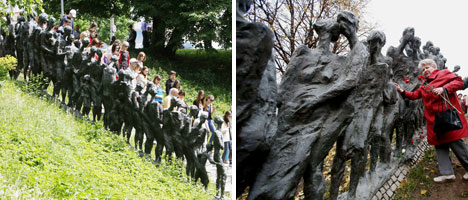 The Pit, a memorial located in Minsk, is a painful reminder of the Nazi inhumanity and a symbol of the eternal sorrow for the genocide victims. One of the largest European ghettos for the Jews was established in the occupied Belarusian capital during the Great Patriotic War. Over 100,000 people were murdered there by late October 1943. The atrocity of 2 March 1942 when the Nazi executed more than 5,000 Jews including 200 orphans from a boarding school together with their teachers and medical staff was one of the multitude of atrocities that took place there. Thousands of corpses of those who were killed in the Minsk ghetto were dumped into the pit that today is marked with an impressive memorial. In the center of the memorial there is a black marble obelisk erected in 1947. The stairs lead to the deep pit form the Last Journey sculpture that features 27 bronze figures moving down the stairs like faceless ghosts…
The Pit, a memorial located in Minsk, is a painful reminder of the Nazi inhumanity and a symbol of the eternal sorrow for the genocide victims. One of the largest European ghettos for the Jews was established in the occupied Belarusian capital during the Great Patriotic War. Over 100,000 people were murdered there by late October 1943. The atrocity of 2 March 1942 when the Nazi executed more than 5,000 Jews including 200 orphans from a boarding school together with their teachers and medical staff was one of the multitude of atrocities that took place there. Thousands of corpses of those who were killed in the Minsk ghetto were dumped into the pit that today is marked with an impressive memorial. In the center of the memorial there is a black marble obelisk erected in 1947. The stairs lead to the deep pit form the Last Journey sculpture that features 27 bronze figures moving down the stairs like faceless ghosts…
The Alley of the Righteous Among Nations near the Pit commemorates the Belarusian people who saved Jews while jeopardizing their own lives. All in all, on the territory of Belarus there were over 100 ghettos for the Jews from Germany, Poland, Austria, and other countries…
Melnikaite Street, Minsk
Memorial in the village of Krasny Bereg commemorating child victims of the Great Patriotic War
The world’s only memorial commemorating child victims of the Great Patriotic War is located in the village of Krasny Bereg. In 1943 the Nazis set up a camp where they used the most inhumane methods to take children’s blood for hospitals of the Hitler army. In the 21st century the memorial was erected at the place of the murder of 1,990 people. The memorial was designed by a group of architects under the supervision of Leonid Levin, the Khatyn Memorial author. Visitors are welcomed at the entrance by a bronze figurine of a girl with arms up and crossed. The Sun Square sends out alleys-rays, with one named Ray of Memory crossing an empty classroom with 21 white desks and a blackboard featuring Katya Susanina’s letter to her father. The memorial also features heart-stirring glass paintings and a symbol of children’s broken dreams, a Paper Shiplet…
The memorial in Krasny Bereg is surrounded by an old apple garden that became another symbol of the horrible tragedy of the village. A legend says that local botanist Nezvedsky planted Chinese apple trees here which turn poppy red in spring and get covered with ruby apples in autumn.
Village of Krasny Bereg, Zhlobin District, Gomel Region
Ozarichi Memorial Complex
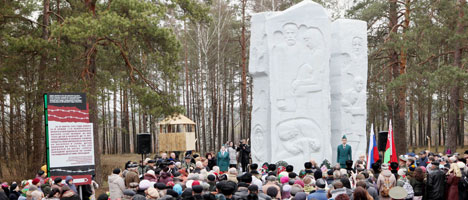 …A heinous death camp existed for only two weeks, but within this short span the Nazis killed 20,000 people. the death camp was created in March 1944, upon the order of Adolf Hitler near the village of Ozarichi in Belarusian Polesye to torture prisoners and weaken the approaching Red Army. People suffering from spotted fever and other infectious diseases which could quickly contaminate local residents and Soviet soldiers were brought to this land of marshes. There were no buildings on the territory of the Ozarichi death zone: women, children and elderly people were kept outdoors; the territory around the death camp was mined. The liberators of the horrible death camp saved more than 30,000 prisoners, more than a half of who were children. The memorial made of three white walls symbolizing Ozarichi death camps with the portraits and names of prisoners was unveiled in 1965.
…A heinous death camp existed for only two weeks, but within this short span the Nazis killed 20,000 people. the death camp was created in March 1944, upon the order of Adolf Hitler near the village of Ozarichi in Belarusian Polesye to torture prisoners and weaken the approaching Red Army. People suffering from spotted fever and other infectious diseases which could quickly contaminate local residents and Soviet soldiers were brought to this land of marshes. There were no buildings on the territory of the Ozarichi death zone: women, children and elderly people were kept outdoors; the territory around the death camp was mined. The liberators of the horrible death camp saved more than 30,000 prisoners, more than a half of who were children. The memorial made of three white walls symbolizing Ozarichi death camps with the portraits and names of prisoners was unveiled in 1965.
The museum of memory of the Ozarichi death zone victims was opened in 2004. It features unique materials such as the memories and voice recordings of eyewitnesses, documents, photographs, correspondence with former prisoners and liberators…
Kalinkovichi District, Gomel Oblast
Memorial complex Lupolovo Prison Camp
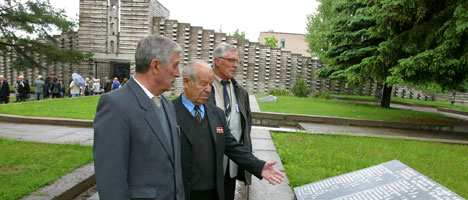 A prison camp for Soviet soldiers was set up by the Nazis in the Lupolovo suburb of Mogilev in August 1941. Prisoners were starved, interrogated and severely tortured. Every day up to 250 people died behind the energized barbed-wire fence. About 80,000 people died in the prison camp, and only 389 names of victims are known. One of the prisoners was General Mikhail Romanov, commander of the famous 172nd rifle division which heroically defended the city of Mogilev in July 1941. The first monument commemorating the victims of the prison camp was erected in 1948. The memorial complex was unveiled in 1984 in honor of the 40th anniversary of the liberation of Mogilev.
A prison camp for Soviet soldiers was set up by the Nazis in the Lupolovo suburb of Mogilev in August 1941. Prisoners were starved, interrogated and severely tortured. Every day up to 250 people died behind the energized barbed-wire fence. About 80,000 people died in the prison camp, and only 389 names of victims are known. One of the prisoners was General Mikhail Romanov, commander of the famous 172nd rifle division which heroically defended the city of Mogilev in July 1941. The first monument commemorating the victims of the prison camp was erected in 1948. The memorial complex was unveiled in 1984 in honor of the 40th anniversary of the liberation of Mogilev.
On the site of the former Lupolovo concentration camp there is also a mass grave of the soldiers of the 238th and 369th rifle divisions of the 2nd Belarusian Front which took part in the liberation of Mogilev in June 1944.
Mogilev


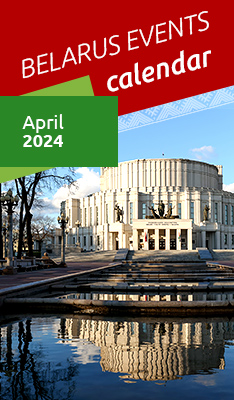




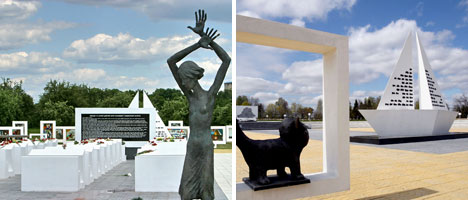
 print version
print version make home page
make home page add to bookmarks
add to bookmarks